Are you looking for ways to make your garden easy to maintain? With these tips and tricks, you can simplify your gardening routine and create a beautiful oasis in your backyard. By selecting the right plants, using ground covers, incorporating hardscape elements, and investing in an irrigation system, you can reduce the time and effort required to maintain your garden.
Key Takeaways:
- Choose low-maintenance plant options
- Use ground covers to reduce weeds and watering needs
- Incorporate hardscape elements for a beautiful space with less maintenance
- Invest in an irrigation system for healthy plants and reduced water usage
- Keep a garden journal to stay organized and on track with maintenance schedules
Choose the Right Plants for Easy Maintenance
One of the key factors in creating an easy-to-maintain garden is choosing the right plants for the right spots in your garden. The right plants will thrive in your garden’s soil and light conditions and won’t outgrow or spread too quickly. By selecting low-maintenance plants, you’ll save time and effort in the long run and enjoy a beautiful garden that requires minimal upkeep.
When planting, it’s important to use additional nutrients like Espoma’s Biotone Plant Starter Plus to promote strong root growth. Plan the layout of your garden according to the sunlight and water availability in different areas, and plant in odd numbers to achieve a more balanced and fuller look.
Size and spacing of plants are also crucial to maintaining an easy-to-care-for garden. Taller plants should not overshadow smaller ones, and each plant should have enough space to grow without crowding others. To reduce weed growth and retain moisture in the soil, use mulch around plants, leaving a gap of 1-1 ½ inches from the base.
Another way to simplify watering is by using a drip irrigation system or a soaker hose. Water plants in the morning at the base for optimal results. To minimize opportunities for weeds to take root, fill in open spaces with grasses and groundcovers. Shrubs and meadow plants are also excellent low-maintenance options that provide year-round presence in the garden. Avoid fast-spreading or invasive perennials and choose sturdy, healthy plants.
Keeping a journal or scrapbook with plant tags and important information about each plant can help keep you organized and make future maintenance easier. Regular maintenance, such as pruning and fertilizing, done in small increments can save time overall.
By following these tips and selecting the right plants, you can create a beautiful garden that requires minimal maintenance and allows you to enjoy your outdoor space without spending excessive time and effort.
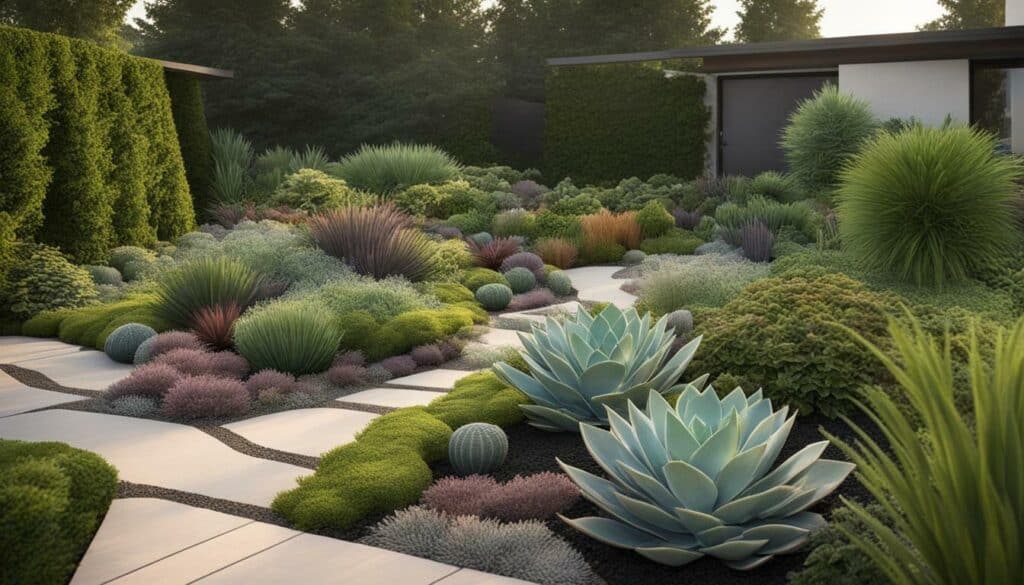
Ensure Strong Plant Growth with Plant Starters
To ensure strong and healthy plants, consider using plant starters when planting in your garden. Choosing the right plants is crucial, but providing them with the necessary nutrients for growth is equally important. Plant starters like Espoma’s Biotone Plant Starter Plus provide a blend of beneficial microbes and mycorrhizae to help establish strong root systems and promote healthy growth.
| Tip: | Choose the right plant for the right spot in your garden. Consider the plant’s size and growth habits to ensure it won’t overgrow the space. |
|---|
Plan your garden layout beforehand, taking into consideration factors like sunlight and water availability. This will help ensure that each plant receives the appropriate amount of light and water as needed.
Using mulch around your plants can help prevent weed growth while retaining moisture in the soil. This can help reduce the time and effort required for watering and weeding.
Opt for low-maintenance plants like drought-tolerant or native varieties, evergreen shrubs, and non-invasive perennials. Avoid planting varieties that attract pests, as this can lead to additional maintenance needs.
Ground covers, hardscape elements, and seating areas can also help reduce maintenance needs by filling in space and reducing the amount of lawn that needs to be mowed or maintained.
Investing in a garden watering system can help to efficiently water your plants and reduce the amount of time and effort required for watering. You may also consider growing low-maintenance plants in containers for easier maintenance and control.
Finally, keeping a garden journal can help you track watering, fertilizing, and pruning schedules. This can aid in planning future maintenance needs and ensure that your plants remain healthy and strong.
By following these tips, you can ensure strong plant growth and enjoy a low-maintenance garden.
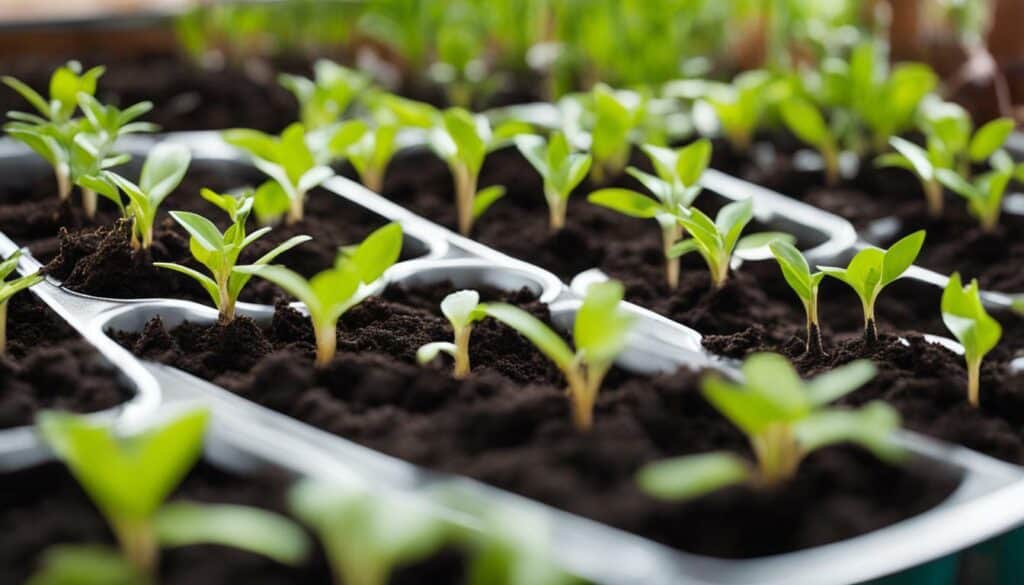
Plan Your Garden Layout for Visual Appeal
A well-planned garden layout not only enhances the visual appeal but also makes maintenance easier in the long run. When designing your low-maintenance garden, there are several factors to consider to ensure a visually appealing and balanced space.
First, selecting the right plants for your garden is crucial. Choose varieties that won’t overgrow your space or spread beyond where you want them to go. Assessing your garden’s soil and light conditions will help you pick plants that will thrive. Consider the sizes and spacing of plants as well to avoid overpowering or overshadowing.
Mulching around plants can be an effective way to prevent weed growth and retain moisture. Installing a drip irrigation system or using a soaker hose can also simplify watering, and ensure your plants receive adequate moisture.
In addition to plants, consider adding grasses, groundcovers, shrubs, and meadow plants to fill in space and reduce opportunities for weeds. Keep in mind that some perennials may be invasive and require more maintenance.
It’s also beneficial to keep a garden journal or scrapbook with plant tags and notes on watering and pruning schedules. This practice will aid in maintenance scheduling and future reference.
By following these easy gardening techniques, it is possible to create a stunning and low-maintenance garden that is easy to care for and visually appealing.

Use Mulch for Weed Prevention and Moisture Retention
Mulching is an effective technique to keep weeds at bay while conserving soil moisture, making it an essential practice for an easy-to-maintain garden. By adding a thick layer of mulch around your plants, you can create a barrier that blocks sunlight and prevents weed seeds from germinating. This way, you can significantly reduce the amount of time you spend weeding your garden and keep it looking tidy and well-maintained.
In addition to preventing weeds, mulch helps to retain moisture in the soil, which can be especially beneficial during dry periods. By keeping the soil moist, you can reduce the frequency with which you need to water your garden, conserving water and saving time. However, it is important to apply mulch about 1-1 ½ inches away from the base of the plants to prevent moisture from accumulating around the stems and causing rot.
There are different types of mulch available, such as organic materials like straw, wood chips, and leaves, or inorganic materials like rocks and gravel. Each type offers different benefits and drawbacks, so it is important to choose the right one for your garden based on your soil type, climate, and the plants you are growing. For example, organic mulches can provide nutrients to the soil as they decompose, but they may also attract pests like slugs and snails.
When using mulch in your garden, it is important to follow other tips for easy maintenance, such as choosing the right plants that are suitable for your soil and climate, limiting the variety of plants you grow, and utilizing ground covers to fill in gaps and prevent weed growth. By combining these techniques, you can create a low-maintenance garden that thrives with minimal effort.
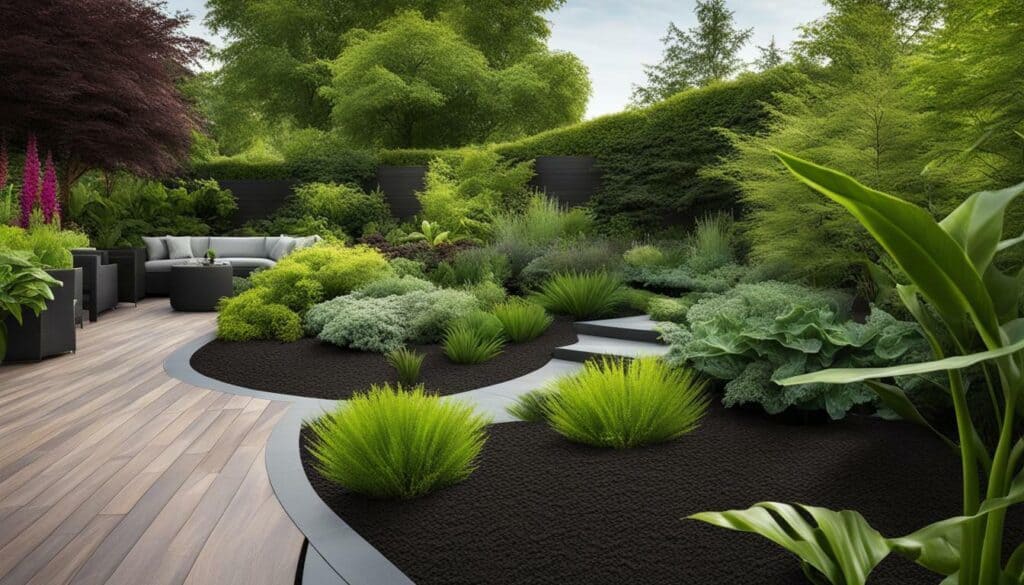
Overall, using mulch is a simple and effective way to maintain a healthy and attractive garden without spending too much time and effort on frequent weeding and watering. With the right approach, you can create an easy-to-maintain garden that provides a beautiful outdoor space for relaxation and enjoyment.
Simplify Watering with Drip Irrigation or Soaker Hoses
Watering can be made easy and efficient by installing a drip irrigation system or using soaker hoses in your garden. These methods ensure that plants are watered regularly and efficiently, reducing the time and effort required for watering. Drip irrigation systems, such as the Proven Winners WaterWise kit, can be automated with timers, making the process even more convenient.
Soaker hoses can be placed below a layer of mulch to deliver water directly to the soil, minimizing water loss through evaporation. Watering in the morning and at the base of the plants is recommended, as it allows the plants to absorb the moisture before the heat of the day causes it to evaporate.
Not only do these efficient watering methods save time and effort, but they also help to maintain the health of your plants. Consistent and appropriate watering is crucial for plant growth and survival, and using drip irrigation or soaker hoses can simplify your gardening routine and ensure your plants receive the water they need.
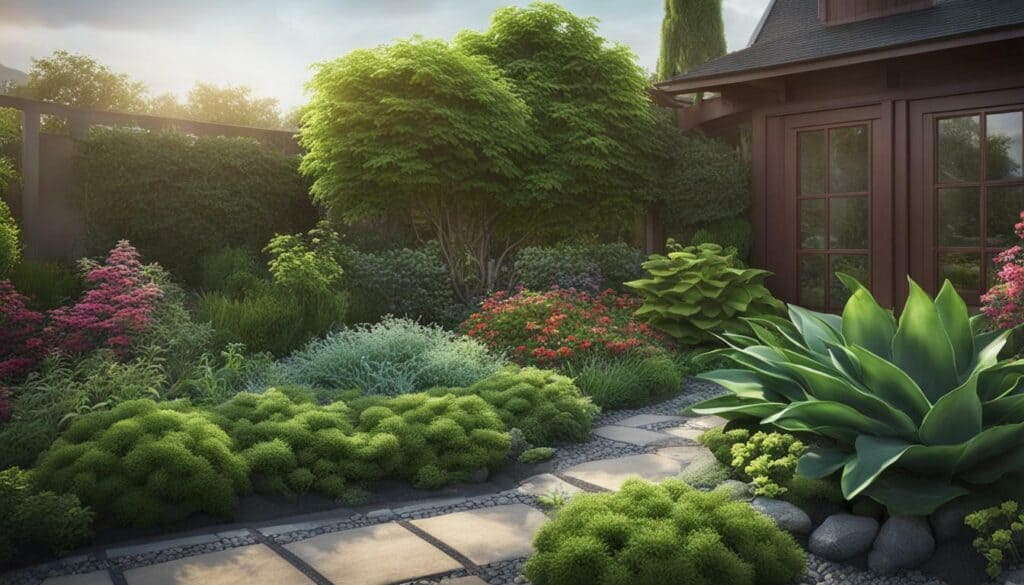
Overall, incorporating a drip irrigation system or using soaker hoses in your garden is a great way to simplify your gardening routine and ensure that your plants receive the water they need to thrive. Whether you’re a beginner or an experienced gardener, these easy plant care techniques are perfect for creating a stress-free, beginner-friendly garden.
Fill in Space with Grasses and Groundcovers
One way to minimize maintenance in your garden is by utilizing grasses, groundcovers, shrubs, and meadow plants to fill in empty spaces. Ground covers, such as ornamental grasses and perennials, can help smother out weeds and reduce the need for frequent watering and fertilizing.
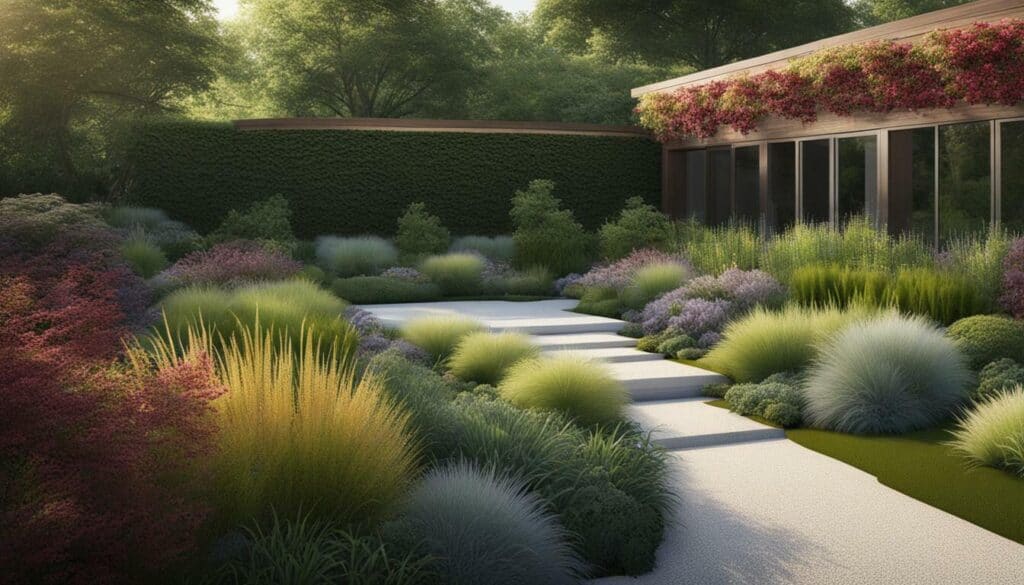
Consider using native plants and evergreen shrubs, which are typically low maintenance and require less pruning. When selecting plants, take into account the soil and light conditions in your garden. Opt for varieties that are well-suited to your specific conditions and avoid those that are prone to overgrowth or spreading too much.
Mulching is another important step in creating a low-maintenance garden. It blocks sunlight, which helps to prevent weed growth, and retains moisture in the soil. A drip irrigation system or soaker hose can also simplify watering, ensuring your plants receive adequate moisture without the need for frequent manual watering.
To keep your garden looking neat and tidy with less effort, opt for a simple layout with clean lines and incorporate hardscape elements such as pavers or decorative stones. These elements add beauty to your garden without requiring regular watering or pruning.
Finally, keeping a journal to track watering, fertilizing, and pruning schedules can help you stay organized and on top of garden maintenance. With careful planning and selection, your low-maintenance garden can be a beautiful and relaxing space for years to come.
Keep a Garden Journal for Maintenance and Reference
Maintaining a garden journal is a simple yet effective way to keep track of plant care and important information about each plant in your garden. By recording details such as planting dates, watering and fertilizing schedules, and pruning dates, you can create a useful tool for maintaining your garden and preventing any confusion or forgetfulness.
To begin your garden journal, start by creating a list of all the plants in your garden, including their common and botanical names. Then, record their location, soil type, light exposure, and any other relevant details. This will help you better understand the individual needs of each plant and ensure that they are receiving the care they require.
In addition to plant care, your garden journal can also be used to track any observations or changes in your garden. For example, you can record the dates of the first and last frost, when specific plants start to bloom, and any pest or disease issues you may encounter.
Having all this information in one place will make it easier to plan and maintain your garden in the long run. You can refer to your journal when deciding what plants to add or remove, when to fertilize or water your plants, and when to prune or harvest fruits and vegetables. It will also help you identify any potential issues or concerns early on, before they become larger problems.
By incorporating a garden journal into your gardening routine, you can simplify plant care and maintenance, allowing you to better enjoy your garden. Remember, the key to an easy-to-maintain garden is proper planning, plant selection, and organization.

Keep in mind: Limiting the variety of plants, using organic matter for garden beds, and selecting low-maintenance and drought-resistant plants can reduce the amount of work needed to maintain your garden. Incorporating hardscape elements, such as pathways, patios, and seating areas, can add beauty to your garden while minimizing maintenance. Ground covers and low-maintenance shrubs can help suppress weeds and reduce the need for mowing. By following these tips and utilizing a garden journal, you can create a beautiful and low-maintenance garden that you can enjoy year-round.
Conclusion
By implementing the tips and tricks mentioned in this article, you can transform your garden into a low-maintenance oasis that is easy to care for. Start by selecting the right plants for your garden, such as native, drought-tolerant, and evergreen varieties. Keep your garden organized and easy to maintain by limiting the variety of plants, utilizing organic matter in garden beds, and incorporating ground covers and hardscape elements.
Installing a watering system, using mulch, and keeping a journal to schedule maintenance tasks will also simplify the process of caring for your garden. By planning your landscape with maintenance in mind and selecting plants and materials wisely, you can achieve a low-maintenance garden that provides a beautiful and stress-free space for you to enjoy.
How Can I Create a Low-Maintenance Garden?
Creating a low-maintenance garden is an effective way to enjoy the joy of gardening without excessive effort. By selecting low-maintenance plants, such as succulents or native varieties, you can reduce watering and pruning requirements. Utilizing mulch helps retain moisture and suppress weed growth. Additionally, incorporating automated irrigation systems and well-planned landscaping design can minimize maintenance needs. Achieving a low-maintenance garden ensures you can fully experience the joy of gardening explained, without spending too much time on upkeep.
What Are Some Easy Gardening Tips and Tricks to Make My Garden Low Maintenance?
If you don’t have a green thumb, gardening can seem overwhelming. But with these easy green thumb gardening tips & tricks, you can make your garden low maintenance. Start by choosing low-maintenance plants that thrive in your climate. Use a thick layer of mulch to suppress weeds and retain moisture. Group plants with similar watering needs together for efficient irrigation. Finally, set up a drip irrigation system to save time and water.
FAQ
Q: What plants should I choose for a low-maintenance garden?
A: Choose plants that are suitable for the soil and light conditions in your garden. Consider plants that are known for their low-maintenance characteristics.
Q: How can I ensure strong plant growth?
A: Using plant starters can help plants establish themselves quickly and build strong root systems, promoting healthy growth.
Q: Why is garden layout important?
A: Planning the layout of your garden and considering the sizes and spacing of plants can create a visually appealing and balanced space.
Q: How does mulch help in gardening?
A: Mulching around plants prevents weed growth and helps retain moisture in the soil, reducing the need for frequent watering.
Q: What is the best way to water plants?
A: Using a drip irrigation system or soaker hose can simplify watering. Watering in the morning at the base of the plant ensures optimal absorption.
Q: How can I prevent weed growth?
A: Filling in space with grasses, groundcovers, shrubs, and meadow plants can help prevent weed growth and create a low-maintenance garden.
Q: Why should I keep a garden journal?
A: Keeping a garden journal with plant tags and information helps with maintenance scheduling and serves as a useful reference for future care.
Source Links
- https://www.linkedin.com/pulse/7-tips-create-low-maintenance-garden-claire-talbot
- https://shiplapandshells.com/12-tips-for-creating-a-low-maintenance-garden/
- https://www.englishgardens.com/top-10-tips-for-low-maintenance-gardening/
- https://www.finegardening.com/article/creating-a-low-maintenance-garden
- https://simplysmartgardening.com/low-maintenance-gardening/
- https://www.gardeningetc.com/design/low-maintenance-garden-ideas
- https://www.countryliving.com/gardening/garden-ideas/g27092607/low-maintenance-flowers/
- https://www.hgtv.com/outdoors/gardens/planting-and-maintenance/low-maintenance-plants-for-easy-landscaping-pictures
- https://www.realsimple.com/home-organizing/gardening/outdoor/impossible-to-kill-outdoor-plants
- https://www.stonefamilyfarmstead.com/how-to-make-your-plants-grow-faster/
- https://www.burpee.com/blog/how-to-make-plant-stems-stronger–and-roots-too.html
- https://joybileefarm.com/how-to-start-seeds/
- https://plantperfect.com/how-to-design-the-perfect-vegetable-garden-layout/
- https://www.bhg.com/gardening/plans/easy/15-no-fuss-garden-plans/
- https://www.homesandgardens.com/advice/how-to-plan-a-garden
- https://oldworldgardenfarms.com/2023/05/14/stop-garden-weeds-mulch/
- https://gardenerspath.com/how-to/composting/mulching-low-maintenance-gardening/
- https://shiftingroots.com/mulching/
- https://learn.eartheasy.com/articles/drip-irrigation-vs-soaker-hoses-which-is-better-for-your-garden/
- https://gardenprofy.com/soaker-hose-vs-drip-irrigation/
- https://homesteadandchill.com/garden-irrigation-solutions/
- https://www.handimania.com/garden/ground-cover-plants.html
- https://www.goodhousekeeping.com/home/gardening/g32440508/best-ground-cover-plants/
- https://www.yahoo.com/lifestyle/12-ground-cover-plants-fill-124500061.html
- https://cottageatthecrossroads.com/how-to-set-up-a-garden-journal/
- https://ginghamgardens.com/diy-garden-journal/
- https://gardenerspath.com/gear/gardening-books/best-gardening-journals/
- https://www.vedantu.com/english/essay-on-gardening
- https://www.ncbi.nlm.nih.gov/books/NBK373975/
- https://www.betterhealth.vic.gov.au/health/healthyliving/gardens-for-all-a-health-activity

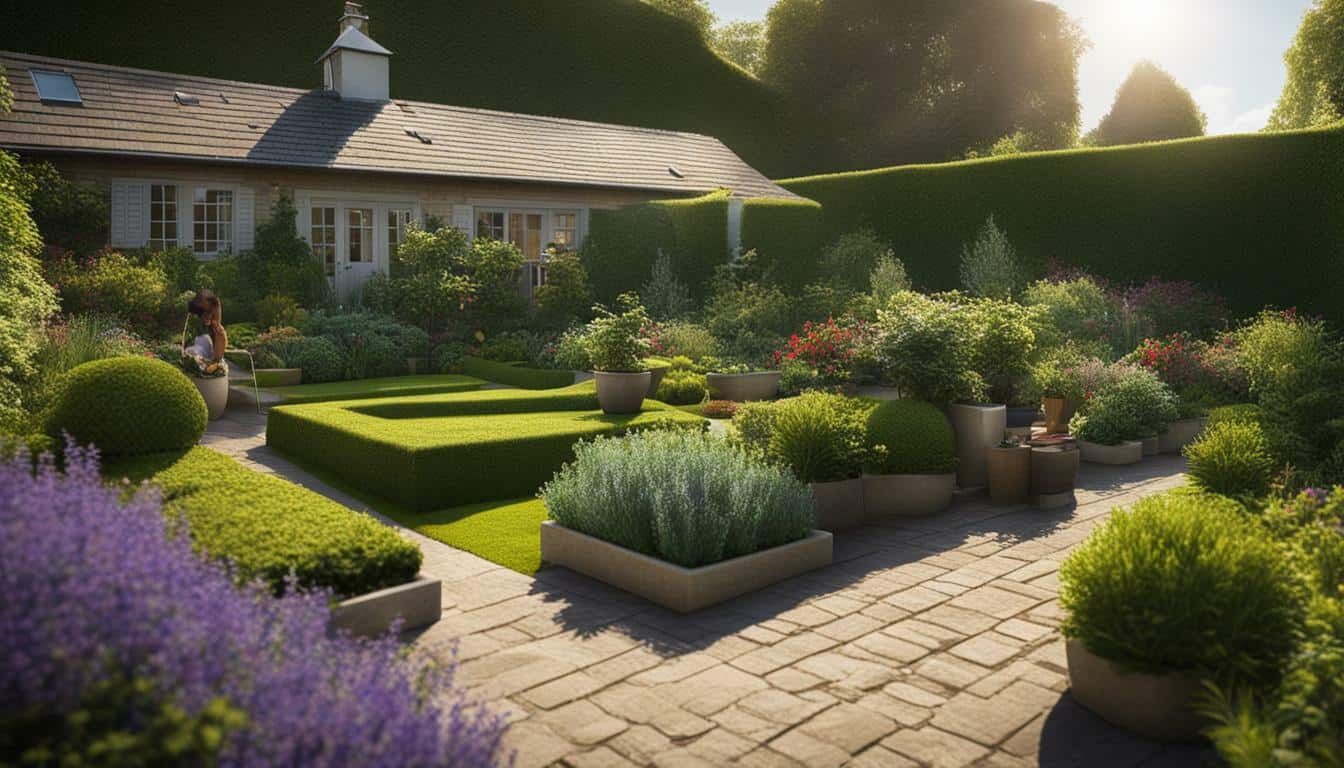



Leave a Reply